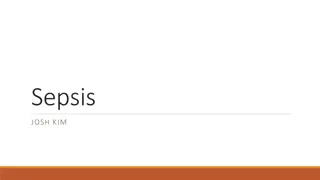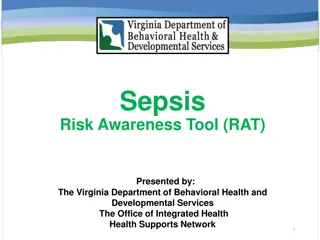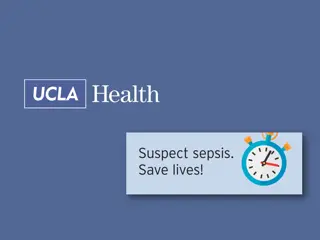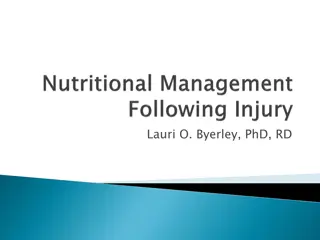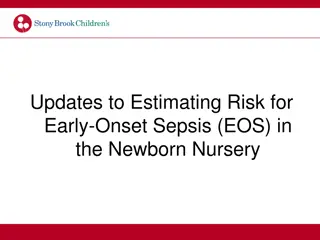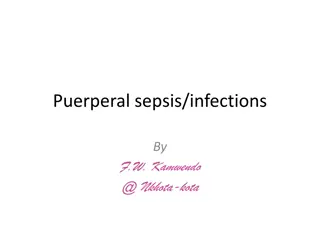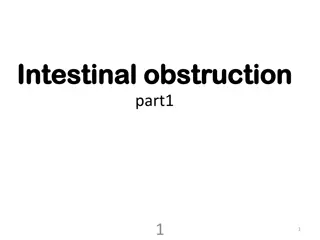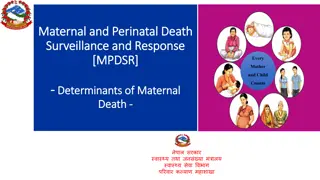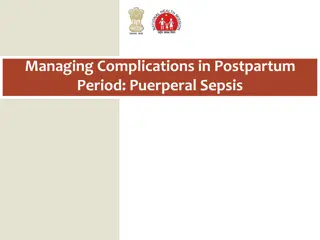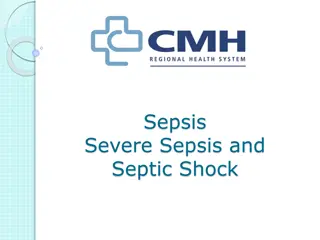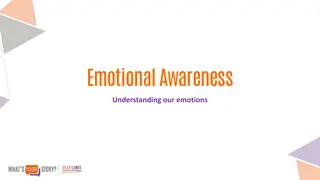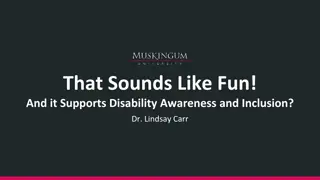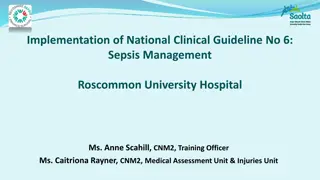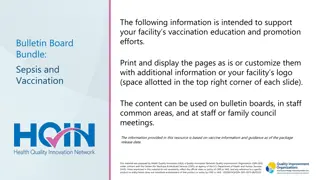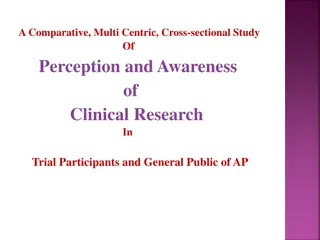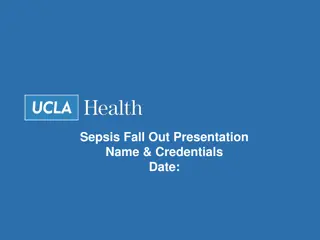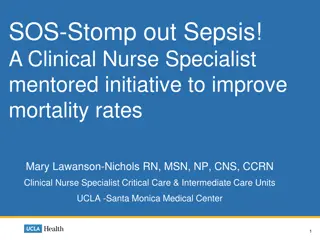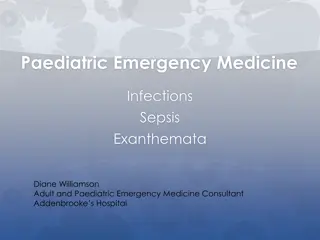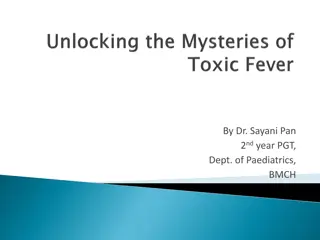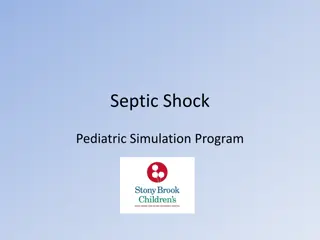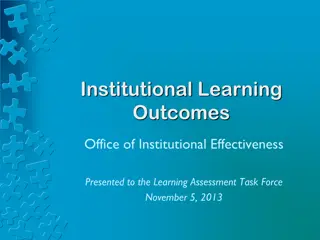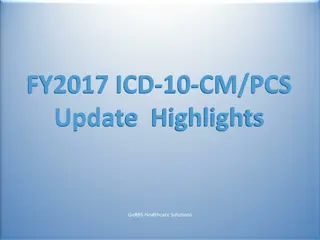DERMATOLOGY AND RHEUMATOLOGY
Staphylococcal Scalded Skin Syndrome (SSSS) is a serious condition characterized by red blistering skin resembling burns. It is caused by toxins from Staphylococcus aureus, leading to exfoliation of the skin. Common in infants, the elderly, and immunocompromised individuals, SSSS requires prompt dia
0 views • 89 slides
Understanding Sepsis: Current Management Strategies and Global Efforts
Sepsis is a life-threatening infectious illness with significant global impact. The World Sepsis Declaration of 2012 underscores the need for improved recognition, prevention, and treatment strategies to address the high burden of sepsis worldwide. Efforts are being made to enhance management guidel
4 views • 118 slides
Risks and Strategies for Safe Caesarean Deliveries in South Africa
Understanding the mortality burden related to caesarean deliveries (CD) in South Africa, this report highlights the need for safe CD practices amidst high maternal death rates. Factors influencing safe CD, checklists for accreditation, and strategies for action plans are discussed. The Case Fatality
0 views • 40 slides
Case Study: Sepsis Presentation and Management in Two Patients
Mrs. NP, a 55-year-old woman with a background of cirrhosis from heavy alcohol use, presented to the ED with symptoms suggestive of sepsis. Examination revealed a febrile state, elevated blood pressure, and altered mental status. Investigations were initiated to determine the cause, with differentia
2 views • 41 slides
Enhancing Pediatric Care with the Irish Paediatric Early Warning System (PEWS)
The Irish Paediatric Early Warning System (PEWS) has been updated to align with National Sepsis Guidance in May 2023. It aims to assist in recognizing and responding to deterioration in pediatric patients, emphasizing the importance of clinical judgment and individualized assessment. PEWS does not r
1 views • 41 slides
Early Vasopressors in Sepsis Clinical Trial: Improving Patient Outcomes
This UK-wide clinical trial aims to assess the effectiveness of early peripheral norepinephrine infusion in adult patients with septic shock. The study will compare the impact on mortality and other outcomes of targeting a mean arterial pressure (MAP) above 65mmHg within the first 48 hours of admiss
1 views • 9 slides
Sepsis Risk Awareness Tool (RAT) Training Program Overview
The Sepsis Risk Awareness Tool (RAT) training program by The Virginia Department of Behavioral Health and Developmental Services aims to educate support coordinators, DSPs, and caregivers about the risk factors, signs, and symptoms of sepsis. It covers definitions, risk factors, signs, symptoms, dia
3 views • 22 slides
The Importance of Self-Awareness in Personal Growth
Self-awareness is crucial for understanding one's character, feelings, and motivations. It helps in recognizing strengths and weaknesses, managing stress, improving communication, and fostering empathy. Developing self-awareness involves introspection, mindfulness, self-reflection, and seeking feedb
2 views • 47 slides
National Audit Results for Severe Sepsis and Septic Shock 2016/17
This presentation outlines the national results of a clinical audit conducted in 2016/17 regarding the management of severe sepsis and septic shock in Emergency Departments (EDs). The audit objectives include benchmarking current performance, facilitating national and peer comparisons, identifying a
0 views • 25 slides
Overview of Acute Pyelonephritis: Diagnosis, Treatment, and Epidemiology
Acute pyelonephritis is a serious bacterial infection of the kidneys, leading to complications such as renal scarring and sepsis. This overview covers key aspects including epidemiology, etiology, clinical presentations, and risk factors. Diagnosis, treatment, and prevention strategies are also disc
0 views • 18 slides
Collaborating to Combat Sepsis: Role of Respiratory Therapists
Sepsis is a critical condition involving infection and inflammation, where the body's response causes widespread symptoms. Learn about the continuum of sepsis, its pathophysiology, and respiratory warning signs. Respiratory therapists play a crucial role in identifying and managing sepsis, with stat
1 views • 14 slides
Implementation of UCLA Sepsis BPA Functionality & Careplan
The UCLA Sepsis Best Practice Alert (BPA) system aids in creating timely and effective care plans for patients diagnosed with sepsis. This comprehensive guide covers the activation triggers, BPA location, creation process, and elements of the Sepsis Careplan, emphasizing the importance of early inte
1 views • 16 slides
Importance of Nutrition in Patient Healing and Recovery
Gain insight into the critical role of nutrition in aiding patients in their recovery from injuries and enhancing their physical well-being post-injury. Explore the phases of injury, the physiological and metabolic impacts of each phase, and the corresponding nutritional support strategies. Delve in
1 views • 49 slides
Understanding Early-Onset Sepsis (EOS) Risk Factors and Management in Newborns
Neonatal Early-Onset Sepsis (EOS) is a rare but life-threatening condition primarily caused by Group B Streptococcus (GBS) or Escherichia coli. Recognizing risk factors such as maternal age, intrapartum fever, GBS colonization, and certain neonatal characteristics is crucial for timely evaluation an
0 views • 26 slides
Improving Sepsis Care Pathways: Rob's Story Highlights Areas for Enhancement
Rob's journey through a sub-optimal sepsis care pathway sheds light on crucial areas for improvement, such as insufficient education, poor communication, tracking issues, and serious implications leading to family distress and legal challenges. The story emphasizes the importance of timely and effec
1 views • 11 slides
Prevention and Management of Puerperal Sepsis and Infections
Puerperal sepsis and infections are serious conditions affecting women postpartum. Puerperal sepsis is characterized by specific symptoms, while puerperal infections are more general. Prevention includes antenatal care, strict intrapartum hygiene practices, and timely interventions. By following gui
2 views • 8 slides
Understanding Intestinal Obstruction: Causes, Classification, and Pathophysiology
Intestinal obstruction can be classified into dynamic and adynamic types, with various causes such as intraluminal faecal impaction, malignancy, and hernia. The pathophysiology involves changes in bowel peristalsis and dilation, leading to potential strangulation and ischemia. Morbidity and mortalit
9 views • 40 slides
Understanding Determinants of Maternal Death: Causes, Factors, and Response
This educational session delves into the determinants of maternal death, distinguishing between causes and factors that increase the risk of maternal mortality. It covers possible determinants like hemorrhage, sepsis, and poor access to healthcare services, and discusses the Three Delays model for i
0 views • 18 slides
Managing Complications in Postpartum Period: Puerperal Sepsis Overview
Puerperal sepsis, a leading cause of maternal death, can be prevented through hygiene practices and early identification. Learn about the risk factors, diagnosis, and prevention strategies for maternal sepsis in the postpartum period.
3 views • 9 slides
Understanding Preterm Delivery: Causes, Complications, and Evaluation
Preterm delivery, defined as labor prior to 37 weeks of gestation, affects approximately 12% of pregnancies worldwide, with almost 30% of these deliveries occurring before 34 weeks. The etiology of preterm birth can vary from maternal factors such as PROM to fetal anomalies and multiple gestations.
0 views • 25 slides
Biomarker-Guided Antibiotic Duration in Sepsis Patients
This research focuses on evaluating the safety and efficacy of a biomarker-guided approach to determine the duration of antibiotic treatment in hospitalized adult patients with sepsis. The study involves a multi-centre randomized controlled trial to assess if a treatment protocol based on monitoring
0 views • 53 slides
Understanding Sepsis and Its Impact on Patient Care
Sepsis is a life-threatening condition resulting from the body's response to an infection, leading to shock, multiple organ failure, and potentially death if left untreated. Recognizing and treating sepsis promptly is crucial, as it has a high mortality rate and can have a significant impact on pati
1 views • 21 slides
Enhancing Emotional Awareness and Self-Awareness for Personal Growth
Understanding our emotions and developing self-awareness are crucial for personal growth and fostering meaningful relationships. Emotions impact various aspects of our lives, from memory and decision-making to creativity and health. Learning to recognize, regulate, and express our emotions authentic
0 views • 15 slides
Understanding and Preventing Sepsis: Vital Information for Caregivers
Sepsis is a life-threatening condition caused by the body's response to infection. Learn about the symptoms, prevention strategies, and how to recognize and respond to sepsis in a healthcare setting. The importance of reporting vital signs accurately and understanding patient behavior is also highli
1 views • 9 slides
Creating Inclusive Spaces: Muskingum University's Disability Awareness Initiatives
Muskingum University celebrates Disability Awareness and Inclusion Month by organizing a variety of events to increase knowledge and active participation. Planning begins months in advance, incorporating diverse perspectives and engaging students in the process. By involving PLUS representatives and
0 views • 14 slides
Implementation of Sepsis Management Guidelines at Roscommon University Hospital
Sepsis, a life-threatening condition, necessitates timely management for improved outcomes. Roscommon University Hospital implemented the Sepsis Screening Program in 2016 with the objective of standardizing practices, educating teams, and assessing outcomes. The initiative includes training, tool im
1 views • 18 slides
Importance of Vaccinations in Sepsis Prevention
Sepsis is a life-threatening response to infection that can lead to organ failure and death. Infection prevention through vaccinations is crucial to combat sepsis. Best practices include obtaining vaccination consent, offering education, and co-administering vaccines to older adults. Accessing vacci
1 views • 8 slides
Contrasting Pathways in Sepsis Care: Rob's Journey
Rob's story illustrates the stark contrast between sub-optimal and optimal pathways in managing sepsis. Delayed recognition and treatment in the sub-optimal pathway led to severe complications, whereas timely intervention in the optimal pathway resulted in improved outcomes. The importance of early
1 views • 7 slides
Exploring Self-Awareness: Insights and Reflections on Leadership and Personal Growth
Delve into the realms of self-awareness through a journey of introspection, personal reflection, and understanding of one's emotional landscape. Discover the seven elements that contribute to self-awareness, learn from the crucible of suffering, and embrace acceptance as a tool for growth. Unravel t
0 views • 17 slides
Perception and Awareness of Clinical Research in Trial Participants and the Public of Andhra Pradesh
This study focuses on understanding the perception and awareness of clinical research among trial participants and the general public in Andhra Pradesh. It highlights the importance of creating awareness about clinical research, previous study results, public attitudes towards clinical trials, and e
0 views • 24 slides
Sepsis Fallout Presentation - Managing Severe Sepsis and Septic Shock
This presentation template guides healthcare professionals on effectively managing severe sepsis and septic shock cases, emphasizing prompt recognition and appropriate interventions. It includes sections on patient background, sepsis criteria, treatment protocols, and debriefing discussions for cont
0 views • 7 slides
Improving Mortality Rates in Sepsis Patients: A Clinical Nurse Specialist Initiative
Clinical Nurse Specialist, Mary Lawanson-Nichols, initiated a program at UCLA-Santa Monica Medical Center to reduce mortality rates in sepsis patients. By focusing on mentoring skills, leadership development for staff nurses, and examining influences on mortality, the program aims to make a signific
0 views • 24 slides
Paediatric Emergency Medicine Overview: Infections, Sepsis, Exanthemata, and Warning Signs
Paediatric emergency medicine involves assessing and managing various conditions in children, such as infections, sepsis, and exanthemata. This overview covers the evaluation of febrile children, warning signs indicating potential serious illness, and the importance of thorough examination and asses
0 views • 48 slides
Case Study: Infant with Persistent Fever and Cry
Aditi Malakar, a 2-month-old female infant, presented with a remittent fever persisting for 9 days unresponsive to antipyretics, along with persistent crying and decreased feeding for the last 2 days. She was referred to the hospital after being diagnosed with sepsis elsewhere. Aditi had a history o
0 views • 31 slides
Coaching Juniors Aged 10-14: Developing Tactical Awareness in Badminton
Introduction to coaching philosophy for junior players aged 10-14, emphasizing hard work, team work, embracing failure as a learning opportunity, and understanding variables outside of one's control. The course covers topics such as tactical awareness, planning, and technique development. Assumption
0 views • 42 slides
Management Strategies for Pediatric Septic Shock Simulation Program
This content provides information on the management of sepsis, including recognition, supportive care, source control, antibiotics, and specific therapies. It emphasizes the importance of initial resuscitation goals, strategies involving fluid resuscitation, inotropic support, and timely administrat
0 views • 12 slides
Mesa Institutional Learning Outcomes Overview
Mesa's Institutional Learning Outcomes (ILOs) focus on core values such as communication, critical thinking, global awareness, personal awareness, civic responsibility, self-awareness, interpersonal skills, and technological awareness. These outcomes are designed to guide students in acquiring essen
0 views • 13 slides
Updates and Highlights in FY2017 ICD-10-CM/PCS
In the FY2017 update of ICD-10-CM/PCS, significant changes have been made with new codes, updates, and deletions affecting coding diagnoses. The update includes coding highlights related to various conditions like bacteriuria, sepsis, pre-diabetes, and Zika virus. The Third International Consensus D
0 views • 30 slides
Enhancing Situational Awareness for Home Visit Safety
Situational awareness is crucial for observing and being attentive to your surroundings to prevent accidents and errors. Understanding different levels of situational awareness, from a relaxed alert state to an active threat response, can significantly improve safety and decision-making in everyday
0 views • 14 slides
Dispelling Myths About Phonemic Awareness in Reading Instruction
Professional development and teaching strategy resources are more effective than specialized phonemic awareness materials. It is essential to integrate phonemic awareness into real reading and writing contexts, rather than teaching it in isolation. Research suggests that the optimal time range for p
0 views • 16 slides



